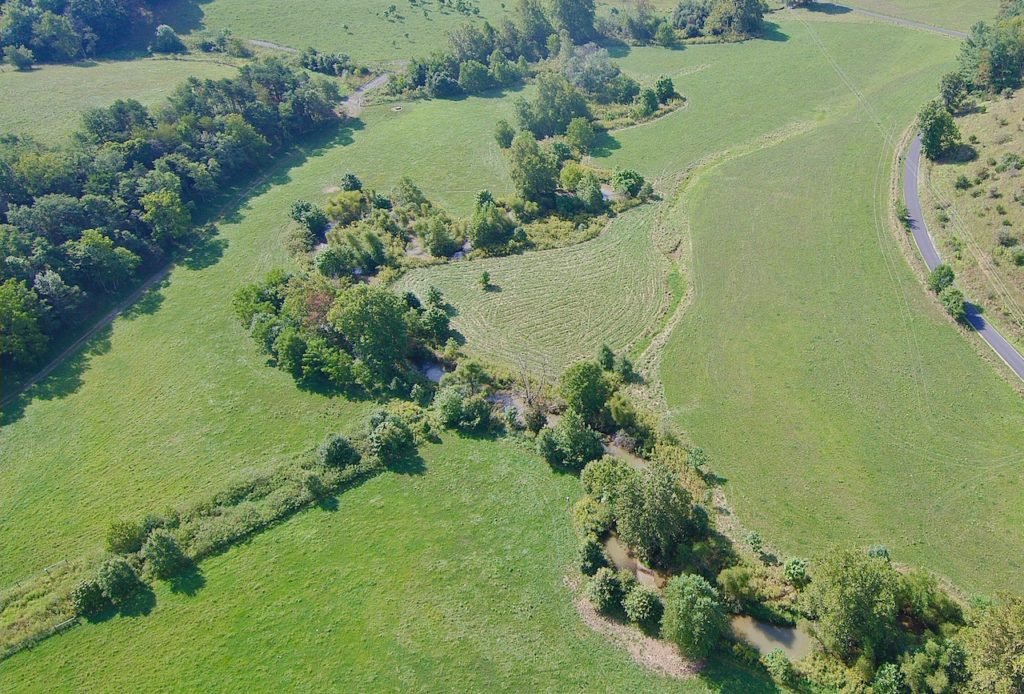October is Riparian Forest Buffer Month! How Cool is That?
I love looking up the trunk of a 30-foot-tall Willow Oak that I planted in 2004. It gives me joy that it grew so tall and fast and that it is helping to heal the earth and our farm. Jeanne and I established six acres of riparian forested buffers along the Middle River and two unnamed tributaries in 2004. Our Middle River farm is in Swoope, Virginia.

This Willow Oak at our Middle River farm was planted in 2004. It is now over 30 feet tall. Photo credit R. Whitescarver
Riparian Forest Buffer Defined
Riparian forest buffer: land adjacent to water capable of reducing the negative impacts of upgradient land and filled enough native trees to support a healthy aquatic ecosystem.
A riparian buffer needs to be wide enough to filter nutrients and sediment that runoff from adjacent land. The buffer could be anywhere from 35 to 100 feet wide depending on the land use beside it. Native trees do so much for the environment. Their roots anchor the stream bank. Their branches shade the water to help reduce the water’s temperature, and that cooler water holds more dissolved oxygen. Colder water and more oxygenated water is more beneficial for Brook Trout habitat. Trees provide wildlife with food and shelter. Leaves sequester carbon, and when they fall into the water, that’s when the magic happens. Those native leaves help feed a healthy aquatic ecosystem. I refer to those leaves as the corn silage of the aquatic ecosystem.
Trees Do So Much
A stream that flows through a forest buffer is two to 8 times more capable of processing in-stream pollution than a stream that doesn’t flow through a forest buffer. Think about that. Eight times more power to process pollution! The Stroud Water Research Center and Dr. Bern Sweeney proved that.

Dr. Bernard Sweeney, senior research scientist and director (retired) of the Stroud Water Research Center standing beside some of the center’s water flumes. Photo credit R. Whitescarver
The Riparian Buffer on Our Middle River Farm Is 17 Years Old
We planted riparian buffers on our Middle River farm in 2004. The trees are now between 20 and 45 feet tall. It’s a joy to walk in the shade along the river. In the spring, I often see Wood Ducks with their babies. I hear the buzzing song of Willow Flycatchers and see many Monarch Butterflies floating in the air to wildflowers such as Burr Marigold and Goldenrod.

These Monarch Butterflies are fueling up on the nectar of Burr Marigolds in our riparian buffers along the Middle River. Photo credit R. Whitescarver

This month, my James Madison University students visited the riparian forest buffer of our Middle River farm. Photo credit R. Whitescarver
Riparian Forest Buffers Remove Pollution
I sampled the river when it enters our farm and when it leaves our farm a half-mile downstream every month for four years. The buffers along our Middle River Farm consistently reduce E. coli in the water by 55 percent.

This is our farm in Swoope, Virginia. The riparian buffers were established in 2004. These buffers reduce E. coli in the river on average by 55 percent. Photo credit M. Corrigan.
Whiskey Creek Angus Farm Prepares for 3,000 Trees and Shrubs
One year ago this month, Jeanne and I purchased a farm in Churchville, Virginia. We named it Whiskey Creek Angus. We installed fences to exclude our cattle from Whiskey Creek and Rye Branch. The Chesapeake Bay Foundation, the Alliance for the Chesapeake Bay, and the Headwaters Soil and Water Conservation District helped us a great deal to fence off 9.3 acres of pasture surrounding the streams. We will plant 3,000 native trees and shrubs in early December.

This Whiskey Creek buffer was mowed in September to prepare for a hardwood tree planting in December. Photo credit R. Whitescarver
James Madison University Samples Whiskey Creek for Critters
This month, Dr. Bruce Wiggins, a biology professor at James Madison University, brought his students to Whiskey Creek Angus to sample the stream for aquatic critters. This will establish a baseline of data as the existing herbaceous riparian buffer transitions to a forested buffer.

Dr. Bruce Wiggins’s JMU students sample Whiskey Creek for critters to establish baseline stream health data. Photo credit R. Whitescarver
Do You Want to Celebrate Riparian Forest Buffer Month?
The best way to celebrate is to plant trees! There are many other ways too. Help clean up a stream, reach out to others with buffer information, contribute to an organization that promotes riparian buffers, support cost-share programs to help farmers establish buffers, adopt a stream, vote for conservation-minded candidates. Need help? Give me a call. I can help you restore the watershed where you live.
The Chesapeake Conservation Landscaping Council initiated this celebration. Thanks for getting the ball rolling. Other supportive organizations not mentioned above include:
Alliance the Shenandoah Valley
The Piedmont Environmental Council
Virginia League of Conservation Voters
Virginia Department of Forestry





9 Comments
Leave your reply.